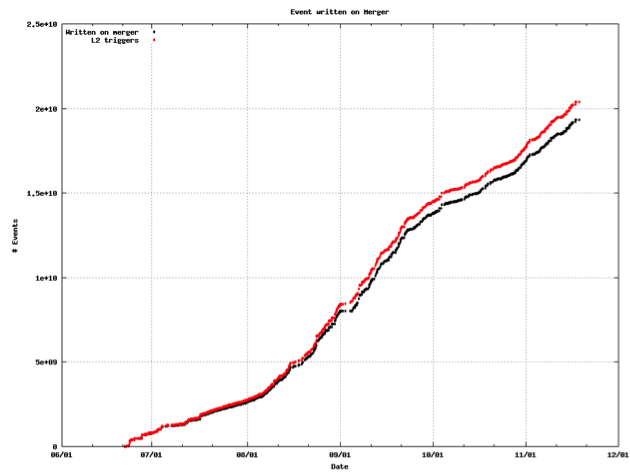NA62 exploits the first high intensity kaon beam of 2015
Last May, the newsletter reported about the two-month pilot run of 2014 and how NA62 was preparing for the 2015 data taking: this became reality for five months between mid-June and mid-November, an exciting but exhausting period for our operation team!
As you may remember, the NA62 experiment focuses on the study of very rare kaon decays. At a time when LHC has started exploring the highest energy ever reached in a hadron collider, kaon physics still remains challenging and important to probe tiny deviations from the so far well mastered Standard Model (SM) of particle physics. In NA62’s quest, the very rare decay mode K+à π+ v vbar is the primary goal (it is predicted to occur in one out of ten billions of kaon decays, a branching fraction of ~10-10) and we need to identify and reject all the other decays, something similar to Hercules’s twelve labors.
The 2015 data taking brought new challenges: from the 2014 pilot run, we knew that the already commissioned detectors were matching the requirements in terms of timing resolution and performances but a few detectors were newly installed: MUV1, one of the two hadron calorimeters and all three GTK stations of silicon pixel detectors, two of them thinned to 100 microns. Last but not least, the digital trigger and the full data acquisition system had not yet been exercised at the nominal beam intensity of 33 1011 protons per pulse (ppp) on T10 target.
Step by step, the beam intensity was increased from a comfortable 3 1011 ppp (10% intensity) to a stable medium 13 1011 ppp (40% intensity) and stressing nominal 33 1011 ppp (100% intensity). We even achieved more than 100% (34 - 35 1011 ppp) by requiring extra protons on the primary target T4: a routine intensity of 33.5 1011 ppp on T10 was recorded in the last hours of running on November 16 (Figure 1).

Figure 1: SPS-PAGE1 on November 16, 2015 at 5:31 am. Note the T10 record intensity of 33.5 ppp and the last comment before the stop at 6:00 am.
This beam period was not without surprises as we discovered many features of our beam and detectors. Several High Voltage power supplies suffered from Single Event Upset (SEU), the fast valve on the vacuum beam tube closed by itself and even some firmware in the readout electronics got corrupted. Actions to prevent such undesirable events in the future have been identified.
At the end of the run we had collected more than 2 1010 triggers (Figure 2) including one week of data taking at 1% intensity for a study of the main “well known/well measured ” kaon decay modes for calibration. The exploitation of the whole data set has already started and will be discussed at length in a collaboration meeting at CERN just before the End of Year break.

Figure 2: integrated number of triggers as a function of time: red line - written on the merger (where information from different sub-systems are put together), black line - accepted as Level2 triggers for final recording.
Technical work during the SPS shut down is also on the way: neon gas has been evacuated from the RICH counter to allow for the necessary replacement of two half-mirrors and the maintenance of the piezo-motors used for fine alignment; the GTK team has launched the production of more detectors to replace the current ones; and various maintenance tasks have already started so the experiment can take data again next spring when the injectors will be back to operation.
Running a medium size experiment as NA62 over a 6 month period means also a lot of human interactions and if we have ~220 registered participants, almost ~140 participated effectively in the operation as Run coordinator (we exhausted 8 of them), as sub-system expert (20 different experts were on site or on call for the whole period) and /or as shifter. Shift training was organized every week for the newcomers or as a “recap” for the older ones. We were very happy to welcome colleagues from Canada (University of British Columbia and TRIUMF) who recently joined the collaboration and colleagues from US and Mexico who spent some time on the experiment during summer.
As you may know, there is a strong Italian component in NA62 that makes life in the counting room very animated (even if sometimes non-Italian speaking colleagues would enjoy joining). Music and humor are of course present with short jingles to attract shifter’s attention on changes: Lacrimosa (W.A. Mozart) if beam is lost, Zarathustra (R. Strauss) if beam is back, Dies Irae (G. Verdi’s requiem) if no trigger, Carmina Burana (C. Orff) on DAQ error…Night shift is welcomed at midnight by “Lonely is the night” (Billy Squier) and ended at 8am with “Here comes the sun” (The Beatles). During the night you may be lucky and meet Mr Badger in the PC farm room. He is a bit shy and hides below the false floor but one day he may join a barbecue or pic-nic at NA62.
Stay tuned to learn more about our quest for the very rare, we will be back in April 2016 !
